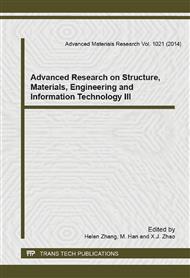[1]
H. C. Liu, L. X. Mao, Z. Y. Zhang and P. Li. Induced aggregation operators in the VIKOR method and its application in material selection. Applied Mathematical Modelling, Vol. 37 (2013), pp.6325-6338.
DOI: 10.1016/j.apm.2013.01.026
Google Scholar
[2]
A. Shanian and O. Savadogo. A material selection model based on the concept of multiple attribute decision making. Materials and Design Vol. 27 (2006), pp.329-337.
DOI: 10.1016/j.matdes.2004.10.027
Google Scholar
[3]
K. Maniya and M.G. Bhatt. A selection of material using a novel type decision making method: preference selection index method. Materials and Design Vol. 31 (2010), pp.1785-1789.
DOI: 10.1016/j.matdes.2009.11.020
Google Scholar
[4]
L. Anojkumar, M. Ilangkumaran and V. Sasirekha. Comparative analysis of MCDM methods for pipe material selection in sugar industry. Expert Systems with Applications, Vol. 41 (2014), pp.2964-2980.
DOI: 10.1016/j.eswa.2013.10.028
Google Scholar
[5]
A. H. Peng and X. M. Xiao. Material selection using PROMETHEE combined with analytic network process under hybrid environment. Materials and Design, Vol. 47 (2013), pp.643-652.
DOI: 10.1016/j.matdes.2012.12.058
Google Scholar
[6]
R. Khorshidi and A. Hassani. Comparative analysis between TOPSIS and PSI methods of materials selection to achieve a desirable combination of strength and workability in Al/SiC composite. Materials and Design, Vol. 52 (2013), pp.999-1010.
DOI: 10.1016/j.matdes.2013.06.011
Google Scholar
[7]
M. R. Mansor, S. M. Sapuan, E. S. Zainudin, A. A. Nuraini and A. Hambali. Hybrid natural and glass fibers reinforced polymer composites material selection using Analytical Hierarchy Process for automotive brake lever design. Materials and Design, Vol. 51 (2013).
DOI: 10.1016/j.matdes.2013.04.072
Google Scholar
[8]
T. W. Liao. A fuzzy multicriteria decision-making method for material selection. Journal of Manufacturing Systems, Vol. 15 (1996), pp.1-12.
DOI: 10.1016/0278-6125(96)84211-7
Google Scholar
[9]
A. S. Milani and A. Shanian. Gear material selection with uncertain and incomplete data. Material performance indices and decision aid model. International Journal of Mechanics and Materials in Design, Vol. 3 (2006), pp.209-222.
DOI: 10.1007/s10999-007-9024-4
Google Scholar
[10]
P. Chatterjee and S. Chakraborty. Material selection using preferential ranking methods. Materials and Design, Vol. 35 (2012), pp.384-393.
DOI: 10.1016/j.matdes.2011.09.027
Google Scholar
[11]
A. Jahan and K. L. Edwards. VIKOR method for material selection problems with interval numbers and target-based criteria. Materials and Design, Vol. 47 (2013), pp.759-765.
DOI: 10.1016/j.matdes.2012.12.072
Google Scholar
[12]
R. J. Girubha and S. Vinodh. Application of fuzzy VIKOR and environmental impact analysis for material selection of an automotive component. Materials and Design, Vol. 37 (2012), pp.478-486.
DOI: 10.1016/j.matdes.2012.01.022
Google Scholar
[13]
Q. Z. Hu and W. H. Zhang. Study and Application of Interval Number Theory. (Science Press, Beijing 2010).
Google Scholar
[14]
Y. Zhang and Z. P. Fan. A method for interval multiple attribute decision making with partial attribute weight information, Journal of Harbin Institute of Technology, Vol. 40 (2008), pp.1673-1675.
Google Scholar
[15]
Z.S. Xu. Uncertain Multiple Attribute Decision Making Methods and Applications. (Tsinghua University Press, Beijing 2004).
Google Scholar
[16]
B.H. Men and C. Liang. Attribute recognition model-based variation coefficient weight for evaluating water quality, Journal of Harbin Institute of Technology, Vol. 37 (2005), pp.1373-1375.
Google Scholar
[17]
A. S. Milani, A. Shanian, R. Madoliat and J. A. Nemes. The effect of normalization norms in multiple attribute decision making models: a case study in gear material selection. Structural and Multidisciplinary Optimization, Vol. 29 (2005).
DOI: 10.1007/s00158-004-0473-1
Google Scholar


